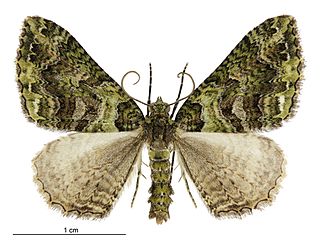
Austrocidaria similata is a species of moth of the family Geometridae. It is endemic to New Zealand and is found throughout the country including on off shore and sub Antarctic Islands. This species inhabits native forest and shrubland. Eggs are while in appearance and oval in shape and take approximately three weeks to mature. Larvae mimic the appearance of a moss covered twig and feed on Coprosma species. It has been hypothesised that this species overwinters as larvae. The larvae pupate on the ground with the pupa being enclosed in a thin cocoon made up of silk and refuse. Adults are on the wing all year but are most commonly observed from October until March. Adults are nocturnal and are attracted to light. During the day they can be observed resting on tree trunks where its forewing colouration provides camouflage protection from predators.

Heterocrossa adreptella is a moth of the Carposinidae family. This species was long considered the New Zealand raspberry budmoth however this was a taxonomic misinterpretation of the type material used to describe this species. This error was corrected in 1988 with the New Zealand raspberry budmoth giving its own species name Heterocrossa rubophaga. H. adreptella is endemic to New Zealand and has been collected in the Wellington Botanic Garden and been observed resting on mānuka branches.

Heterocrossa gonosemana is a species of moth in the family Carposinidae. It is endemic to New Zealand and is found throughout the country. It inhabits native forest. Larvae feed on seeds and fruit of Griselinia lucida and possibly Griselinia littoralis. They can be extremely active when disturbed. This species overwinters as a pupa, enclosed in a cocoon, underneath its host plant. Adults are on the wing from November until February and can be found during the day resting on lichen covered tree trunks where they are well camouflaged. The adult is nocturnal and is attracted to light.
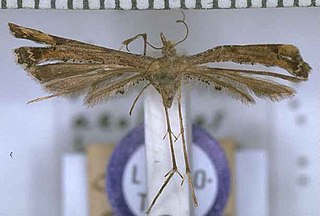
Amblyptilia aeolodes is a moth of the family Pterophoridae. This species was first described by Edward Meyrick in 1902. It is endemic to New Zealand and is found on the Chatham Islands, Big South Cape Island, and the subantarctic Auckland and Campbell Islands.The larvae feed on dicotyledonous herbs.

Amblyptilia deprivatalis is a moth of the family Pterophoridae. This species was first described by Frances Walker in 1864. It is endemic to New Zealand and is found in the North and South Islands. Adults are on the wing from October to May and have an affinity to species in the genus Senecio.
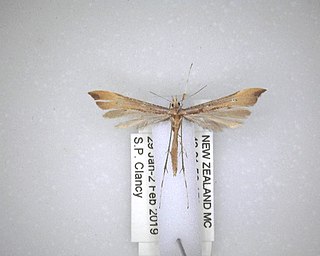
Amblyptilia heliastis is a moth of the family Pterophoridae. This species is endemic to New Zealand. It was first described by Edward Meyrick in 1885. The larvae of this species feed on Veronica species. The adults of this species are on the wing from October to February and can often be found amongst subalpine Veronica species.
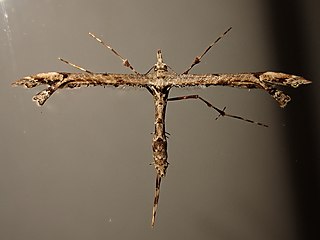
Amblyptilia repletalis is a moth of the family Pterophoridae. It is endemic to New Zealand and can be found throughout the country from North Cape to Bluff. The species inhabits a variety of habitats including native forest clearings, shrubland, coastal dunes and gardens. Larvae feed on the seed heads of Plantago plant species. Adults are on the wing all year round and are attracted to light.
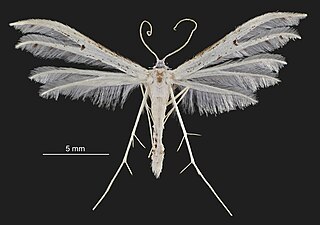
Pterophorus monospilalis, the white plume moth, is a moth of the family Pterophoridae. It is endemic to New Zealand and occurs throughout the country. It inhabits native forest, parks and domestic gardens. Larvae are active during the day, are slow moving, and feed exposed. They feed on Araliaceae species as well as on Hedera helix, Meryta sinclairii, and Schefflera digitata. There are several broods in a year. Adult moths are on the wing from November until May and are attracted to light.

Pterophorus furcatalis, the Pittosporum plume moth, is a moth of the family Pterophoridae. It was first described by Frances Walker and is endemic to New Zealand. This species can be found throughout the North, South and Stewart Islands. Its preferred habitat is dense native bush. Larval host plants include Pittosporum eugenioides and Pittosporum crassicaule. Adult moths are on the wing from November to March and are attracted to light.
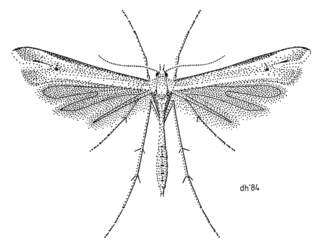
Amblyptilia lithoxesta is a moth of the family Pterophoridae. It is endemic to New Zealand. It was first described by Edward Meyrick in 1885. This species inhabits rough herbage on mountain sides. Larvae feed on Veronica buchananii. Adults are on the wing in January.

Pasiphila bilineolata is a moth in the family Geometridae. It is endemic to New Zealand and can be found in the North and South Islands. The species inhabits native forest and shrubland and the larvae feed on Hebe species. Adults are on the wing commonly from August to January but have been observed most months of the year and are attracted to light.
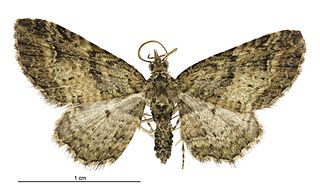
Pasiphila charybdis is a species of moth in the family Geometridae. It is endemic to New Zealand.

Epiphryne undosata, also known as the lacebark looper, is a moth of the family Geometridae. It is endemic to New Zealand and is found on both the North and South Islands. It inhabits native forest. The larvae feed on plant species in the genera Hoheria and Plagianthus. They pupate amongst dead leaves in a silk cocoon. The adult moths have been observed on the wing all year round but are most commonly seen from November until February. The adult moths are extremely variable in both their colour intensity and wing pattern.

Helastia cinerearia is a moth of the family Geometridae. It is endemic to New Zealand and can be found in the North, South and Stewart Islands as well as on the Mercury and Chatham Islands. The preferred habitat of H. cinerearia includes urban gardens, various types of forest and sub alpine habitats. The larval host is lichen on rocks. The adult moths are on the wing all year round but are most commonly observed from September until February. Adult moths are nocturnal and have been observed feeding from and likely pollinating Hebe salicifolia, Hoheria lyallii and Leptospermum scoparium.

Glaucocharis elaina is a species of moth in the family Crambidae. This species was described by Edward Meyrick in 1882. It is endemic to New Zealand and is found throughout the North and South Island with the exception of the extreme south of the South Island. The preferred habitat of this species is lowland native forest and as adults the species is attracted to broken ground including road or rail cuttings. Larvae feed on moss species including those in the genus Funaria. This species has two distinct broods during each year. Adults are on the wing from October to April, are nocturnal and are attracted to light.

Erechthias hemiclistra is a species of moth of the family Tineidae. It was first described by Edward Meyrick in 1911. This species is endemic to New Zealand and has been observed in both the North and South Islands. This species inhabits native forest and have an affinity for species in the genera Phormium,Cortaderia and Cordyline likely as a result of the larvae of this species feeding on dead fibre sourced from species in these genera. Adults are on the wing from September to April but are most commonly observed in December and January. Adults are attracted to light.
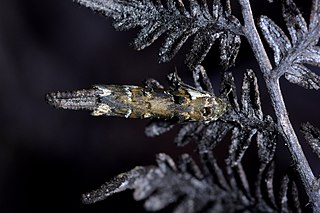
Trachypepla conspicuella is a species of moth in the family Oecophoridae. It is endemic to New Zealand and is found in both the North and South Islands. It is similar in appearance to its close relative T. euryleucota but tends to be paler. Its colouration imitates bird droppings. Larvae feed on leaf litter. Adults of this species are on the wing from November to February and have been observed resting on fences and walls.
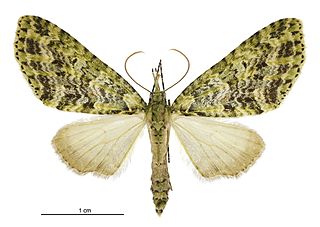
Tatosoma tipulata, also known as the kāmahi green spindle, is a species of moth in the family Geometridae. It was first described by Francis Walker in 1862. It is endemic to New Zealand and occurs in the North, South and Stewart Islands. This species inhabits native bush. The larvae have been recorded as feeding on Pterophylla racemosa, Nothofagus cliffortioides and Podocarpus totara. Adult moths are most commonly observed on the wing from September until March. Adults are nocturnal and are slightly attracted to light. They have also been collected via sugar traps. During the day adults can often be observed resting, camouflaged against moss and lichens, on the trunks of trees.
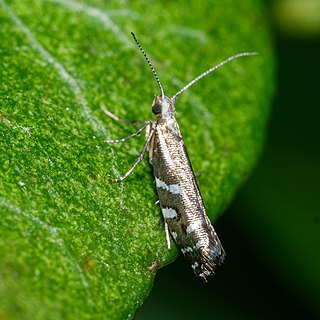
Chrysorthenches glypharcha is a species of moth in the family Plutellidae. It was first described by Edward Meyrick in 1919. It is endemic to New Zealand and is found in the North and South Islands. This species inhabits native forest with Podocarpus trees present. The larva and pupa of this species is currently unknown but the adults are on the wing in February, October and November. The adult moths are associated with Podocarpus totara and Podocarpus laetus.
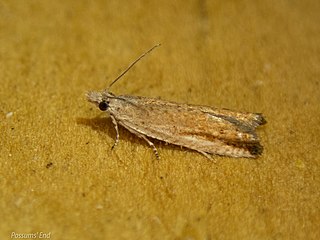
Holocola zopherana is a species of moth in the family Tortricidae first described by Edward Meyrick in 1881. This species is found in Australia and New Zealand. The larval hosts of this moth are Kunzea ericoides as well as species within the plant genus Leptospermum.
























